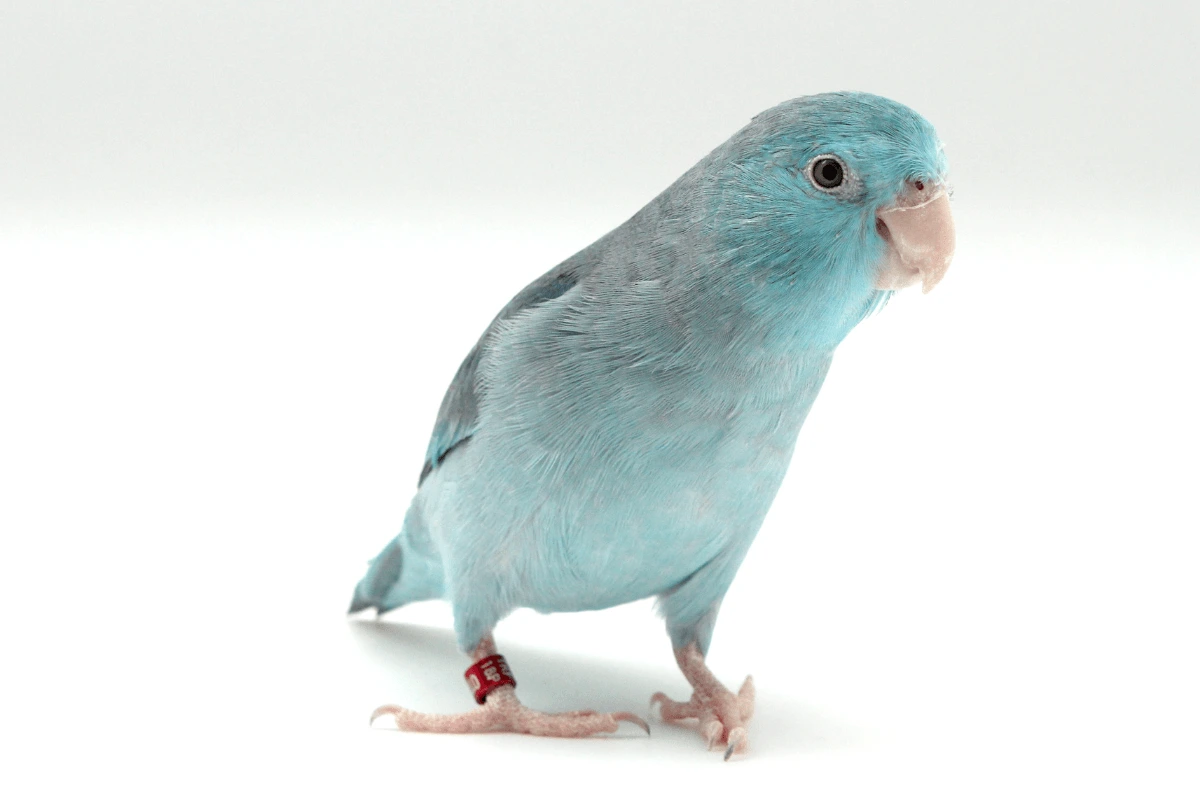The Turquoise Parrotlet is a small yet lively companion that captivates bird enthusiasts with its vibrant feathers and bold personality. Unlike larger parrots, this tiny bird fits perfectly into homes of all sizes while still displaying an impressive level of intelligence and charm. Many bird lovers appreciate the Turquoise Parrotlet for its playful nature, affectionate tendencies, and ability to form strong bonds with its owners.
Caring for a Turquoise Parrotlet requires more than just providing food and a cage. These birds need mental stimulation, proper nutrition, and a safe environment to thrive. They also benefit from regular training and socialization to ensure they develop into well-behaved, friendly pets. Whether you’re considering bringing one home or already own one, understanding their needs will help you create the best possible life for your feathered friend.
In this guide, you’ll learn everything about Turquoise Parrotlet care, from setting up the ideal habitat to maintaining a balanced diet. You’ll also discover essential tips on training, grooming, and keeping your parrotlet healthy for years to come. Let’s dive into the world of these charming little birds and explore how to give them the love and care they deserve.
Understanding the Turquoise Parrotlet
Overview of the Forpus Genus and the Turquoise Parrotlet
The Turquoise Parrotlet belongs to the Forpus genus, a group of small parrots known for their compact size, playful demeanor, and bold personalities. Forpus parrotlets are often referred to as “pocket parrots” because of their small stature, but they possess the intelligence and energy of much larger parrots. Native to Central and South America, these birds thrive in warm climates and dense forests, where they live in small flocks and form strong pair bonds.
The Turquoise Parrotlet is a color mutation of the Pacific Parrotlet (Forpus coelestis), one of the most popular parrotlet species in captivity. Its stunning blue-green feathers set it apart from other parrotlets, making it a sought-after pet among bird lovers. While small, this bird carries a confident and sometimes feisty attitude, making it an engaging and entertaining companion for those willing to invest time in its care.
Turquoise Parrotlet Personality
Despite their tiny size, Turquoise Parrotlets have big personalities. These birds are curious, independent, and highly intelligent, often showing a surprising level of confidence. Many owners describe them as fearless, as they will eagerly explore their surroundings and even challenge much larger pets. When properly socialized, they form deep bonds with their owners and enjoy interactive play.
Although affectionate, they also have a stubborn streak, which means training and socialization should start early. Without proper handling, parrotlets can become territorial or nippy, but with patience and consistent training, they can grow into loving and well-mannered companions. Their energetic nature requires plenty of stimulation through toys, enrichment activities, and social interaction. Whether they are perching on your shoulder or engaging in playful antics, Turquoise Parrotlets always bring excitement to their owners’ lives.
Turquoise Parrotlet Lifespan
A well-cared-for Turquoise Parrotlet can live between 15 to 20 years, making them a long-term commitment for any bird owner. Their lifespan depends on factors such as diet, environment, and overall health care. Providing a nutritious diet, regular exercise, and mental stimulation helps ensure they live a full and happy life.
Like all parrots, parrotlets are prone to certain health issues, including obesity, vitamin deficiencies, and respiratory infections. Regular check-ups with an avian veterinarian can help catch potential problems early and keep your parrotlet in peak health. Creating a bird-safe environment, maintaining a well-balanced diet, and offering plenty of enrichment will contribute to a long, fulfilling life for your feisty little companion.
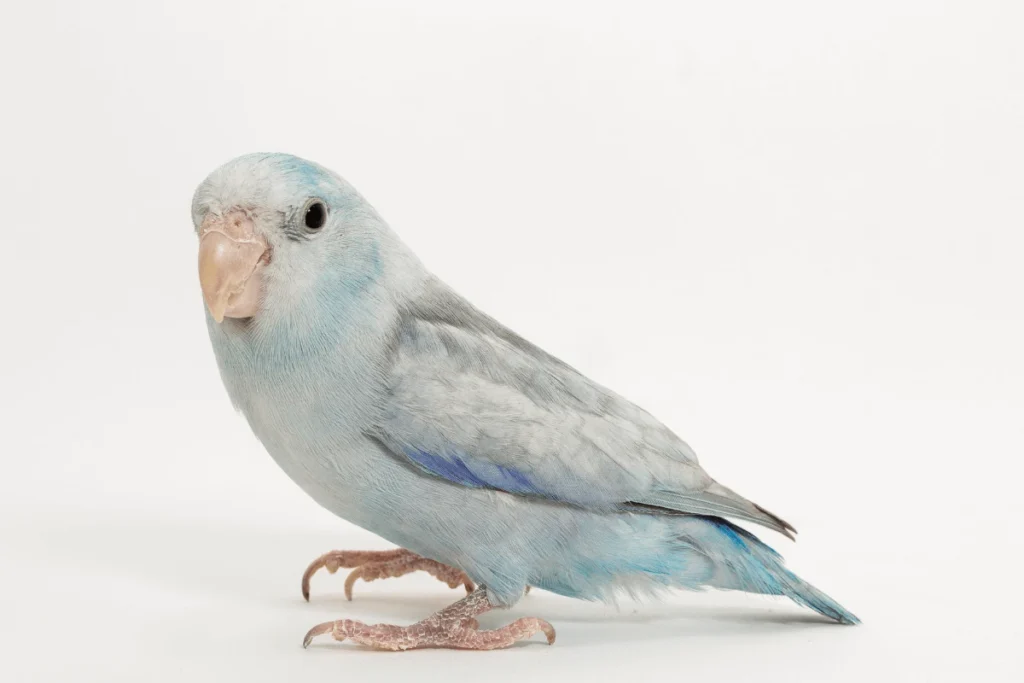
Creating the Perfect Habitat for Your Parrotlet
Parrotlet Cage Setup
Providing a well-designed parrotlet cage setup is crucial for keeping your Turquoise Parrotlet healthy, happy, and mentally stimulated. Despite their small size, parrotlets are highly active birds that need plenty of space to move, explore, and play. A cage should be at least 18 x 18 x 24 inches with narrow bar spacing (around ½ inch) to prevent escape or injury. Larger cages are always better, as they allow more room for flight and exercise.
Inside the cage, place multiple perches of varying sizes and textures to keep their feet strong and prevent foot problems. Natural wood perches are ideal because they mimic the rough surfaces found in nature. Avoid sandpaper perches, as they can cause irritation or injury. The cage should also include a spacious food and water dish, as well as a designated area for bathing, since parrotlets enjoy splashing in shallow water to keep their feathers clean.
Position the cage in a quiet but social part of your home, away from direct sunlight, drafts, and kitchen fumes. Parrotlets are social but can become stressed by excessive noise or too much activity. Ensuring a comfortable and well-organized cage setup will help your parrotlet feel secure and encourage natural behaviors like climbing, exploring, and playing.
Bird Toys and Enrichment
Toys and enrichment activities play a vital role in preventing boredom and destructive behavior in Turquoise Parrotlets. These intelligent birds require constant mental and physical stimulation to stay happy. A variety of bird toys should be available in their cage, including chewable toys, shreddable paper, bells, and interactive puzzle toys. Rotating these toys every few weeks keeps things exciting and prevents them from losing interest.
Foraging toys are especially beneficial because they encourage natural problem-solving skills. Hide small treats inside wooden or cardboard puzzle toys to challenge your parrotlet and keep them engaged. Climbing toys like ladders, ropes, and swings help provide exercise and entertainment.
Beyond toys, daily interaction with their owner is essential. Hand-feeding treats, engaging in simple training exercises, and allowing safe out-of-cage playtime will strengthen the bond between you and your parrotlet. Without proper enrichment, parrotlets may develop negative behaviors like excessive chewing, screaming, or aggression, so offering a stimulating environment is key.
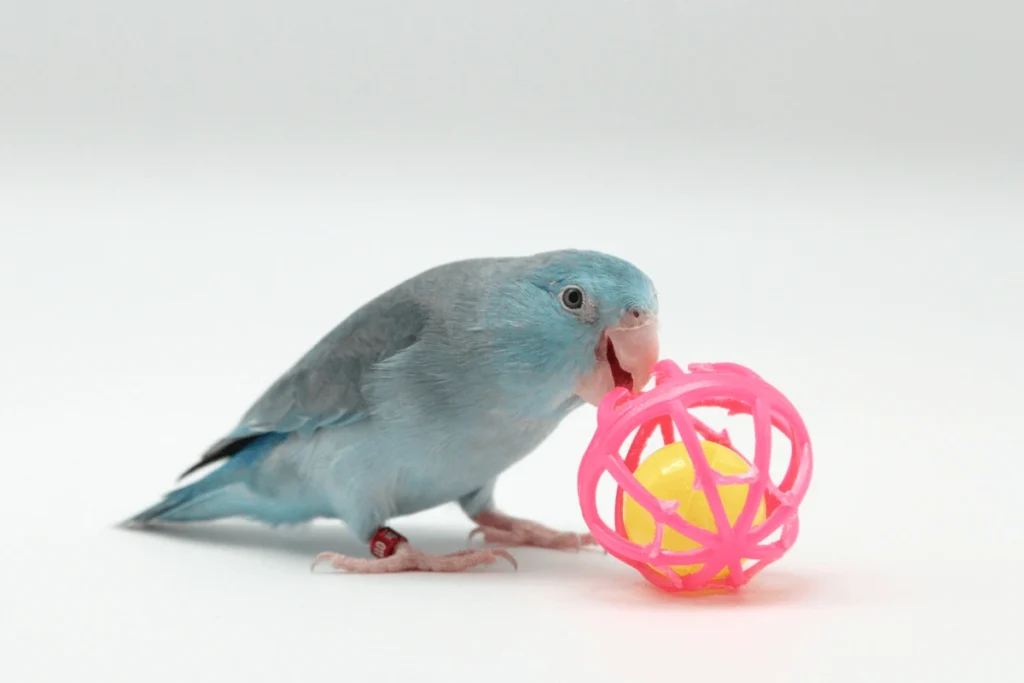
Bird-Safe Environment
Creating a bird-safe environment ensures your Turquoise Parrotlet stays protected while exploring outside its cage. Parrotlets love to fly and investigate their surroundings, so eliminating household hazards is crucial. Windows, mirrors, and open doors can be dangerous if a bird is startled and flies into them. Close doors and windows, and consider using sheer curtains to make glass surfaces more visible to your bird.
Avoid using toxic household items, including non-stick cookware (Teflon), scented candles, air fresheners, and chemical cleaners, as the fumes can be deadly to birds. Keep electrical cords, small objects, and poisonous houseplants out of reach to prevent accidental ingestion or injury.
If you choose to allow free flight, create a designated safe area where your parrotlet can explore without the risk of injury. Remove other pets from the room during out-of-cage time to prevent accidents. Some owners opt for wing clipping, though this is a personal and sometimes controversial decision. If clipping is chosen, it should be done by a professional to ensure safety.
By setting up a secure environment, you give your parrotlet the freedom to explore, exercise, and interact with you safely. A well-planned space encourages natural behaviors and reduces stress, making for a happy and well-adjusted bird.
Proper Diet and Nutrition for a Healthy Parrotlet
Turquoise Parrotlet Diet
Feeding a well-balanced Turquoise Parrotlet diet is essential for maintaining their health, energy, and vibrant feathers. In the wild, parrotlets eat a variety of seeds, fruits, vegetables, and even small insects. In captivity, owners should aim to replicate this diverse diet to ensure their bird gets the proper nutrients. A combination of pellets, seeds, fresh fruits, and vegetables provides the best nutrition for a healthy parrotlet.
Fresh foods should make up about 30–40% of their diet. Offer a mix of leafy greens, carrots, bell peppers, apples, and berries to supply essential vitamins and antioxidants. Chop vegetables into small, bite-sized pieces to make them easier for your parrotlet to eat. Whole grains like cooked quinoa, brown rice, and oats can also be given occasionally as a nutritious supplement.
Water should always be fresh and clean. Replace it daily to prevent bacteria buildup, and consider offering a shallow dish for occasional water play, as many parrotlets enjoy bathing. Providing a nutrient-rich diet supports your bird’s immune system, energy levels, and feather quality, helping them live a long and healthy life.
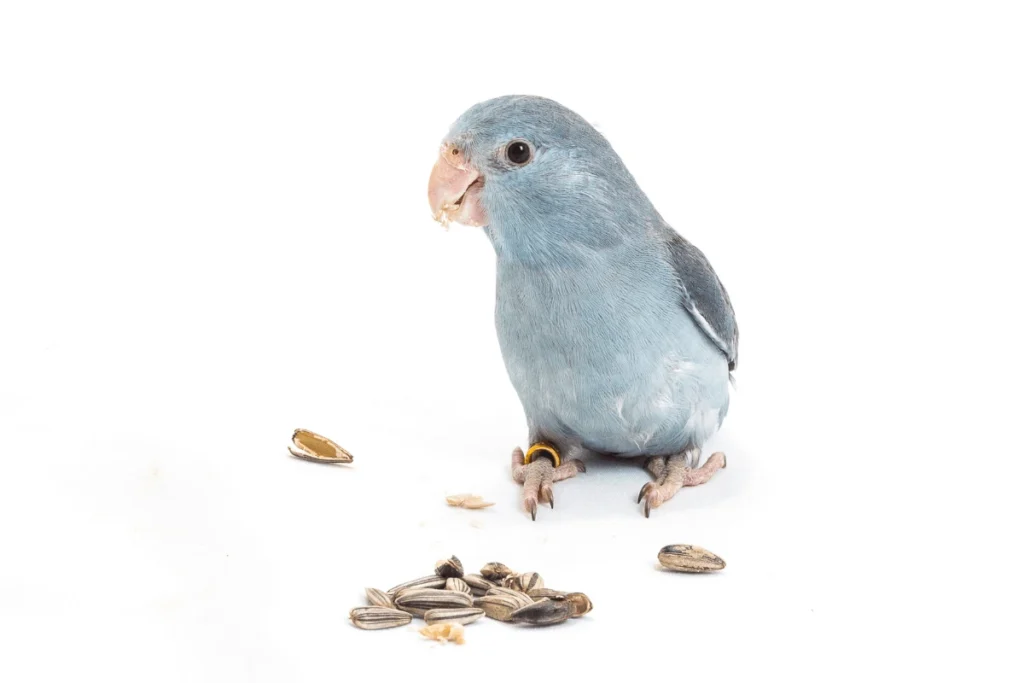
Importance of High-Quality Pellets and Seeds
While fresh foods are important, a high-quality pellet should form the foundation of your Turquoise Parrotlet’s daily diet. Pellets are specially formulated to provide essential vitamins and minerals that seeds alone cannot offer. Look for pellets made from natural ingredients without artificial colors, preservatives, or added sugars.
Although parrotlets love seeds, a diet consisting only of seeds can lead to malnutrition and health problems like obesity and fatty liver disease. Seeds should make up no more than 10–20% of their diet and should be provided as a treat rather than a staple food. If offering seeds, choose a healthy mix with limited sunflower seeds, as they are high in fat and can contribute to weight gain if overfed.
Variety is key when it comes to nutrition. Combining high-quality pellets, fresh produce, and occasional seeds ensures that your parrotlet receives the nutrients needed for strong bones, healthy feathers, and a robust immune system.
Foods to Avoid for Safety and Health
Certain foods can be toxic or harmful to Turquoise Parrotlets, so it’s important to know what to avoid. Some common household foods that are dangerous for birds include:
- Avocado – Contains persin, a toxin that can cause serious illness or death.
- Chocolate and caffeine – Highly toxic to birds and can cause heart problems.
- Onions and garlic – Can damage red blood cells and lead to anemia.
- Alcohol and sugary drinks – Harmful to a parrotlet’s liver and overall health.
- Dairy products – Birds cannot digest lactose, which can lead to digestive issues.
- Fruit pits and apple seeds – Contain cyanide and should never be fed.
- Salty or processed foods – Too much sodium can cause dehydration and kidney issues.
Always wash fruits and vegetables thoroughly before feeding them to remove pesticides and harmful chemicals. Avoid feeding your parrotlet anything high in sugar, fat, or artificial ingredients. Keeping a bird-safe diet will ensure your feathered friend stays healthy, active, and full of energy.
Training and Socializing Your Parrotlet
How to Tame a Parrotlet – Hand-Taming Techniques
Taming a Turquoise Parrotlet requires patience, consistency, and gentle interaction. These birds are naturally curious but can also be independent and stubborn, so building trust is essential for a strong bond. Hand-taming helps your parrotlet feel comfortable with human interaction and makes handling easier for training, grooming, and socialization.
Start by placing your hand near the cage daily without making sudden movements. Speak softly to reassure your bird and allow it to observe your presence without fear. Once your parrotlet shows curiosity instead of nervousness, offer a small treat (such as millet spray) through the cage bars to create positive associations with your hand.
After your parrotlet accepts treats confidently, begin inside-cage training by slowly placing your hand inside the cage and keeping it still. Let the bird approach on its own terms. When it becomes comfortable, encourage step-up training by gently pressing your finger against its lower chest while offering a treat. Repeat this process daily in short sessions to reinforce trust and encourage interaction. Over time, your parrotlet will learn that your hand is safe, making handling and bonding much easier.
Parrotlet Behavior Training
Training a Turquoise Parrotlet is essential to ensure good behavior and prevent unwanted habits like biting or excessive screeching. Since parrotlets are intelligent and independent, they respond best to positive reinforcement training using rewards like treats, verbal praise, or gentle head scratches.
Start with basic commands like “step up”, where your parrotlet learns to perch on your finger or hand. Use a consistent voice command each time you practice, and reward the behavior immediately to reinforce learning. If your parrotlet bites, avoid pulling your hand away suddenly, as this can encourage nipping as a means of control. Instead, remain calm and redirect its attention to a toy or treat.
Target training with a clicker or small stick can help teach your parrotlet to move toward a desired location, making it useful for recall training and reducing fear of new environments. Training sessions should be short and engaging—parrotlets have a limited attention span, so keeping sessions under 10 minutes ensures they stay interested and cooperative.
Bird Socialization
Socializing your Turquoise Parrotlet is crucial for preventing aggression, territorial behavior, and fearfulness. While these birds are small, they are naturally confident and can become dominant if not handled regularly. Daily interaction is necessary to ensure they remain friendly and well-adjusted.
Introduce new experiences slowly and positively. If you have other birds or pets, supervise interactions carefully and never force direct contact. Turquoise Parrotlets can be territorial, especially toward other birds, so separate play areas are recommended if they do not get along.
Allow your parrotlet to explore new environments under supervision. Letting them perch on different surfaces, experience new toys, and hear varied sounds will help them become adaptable and less fearful of changes. Encourage family members or trusted friends to interact with the bird using treats and gentle handling to prevent the parrotlet from bonding with only one person.
A well-socialized parrotlet is confident, affectionate, and eager to interact with people. With consistent training and positive experiences, your bird will develop into a friendly, well-mannered companion.
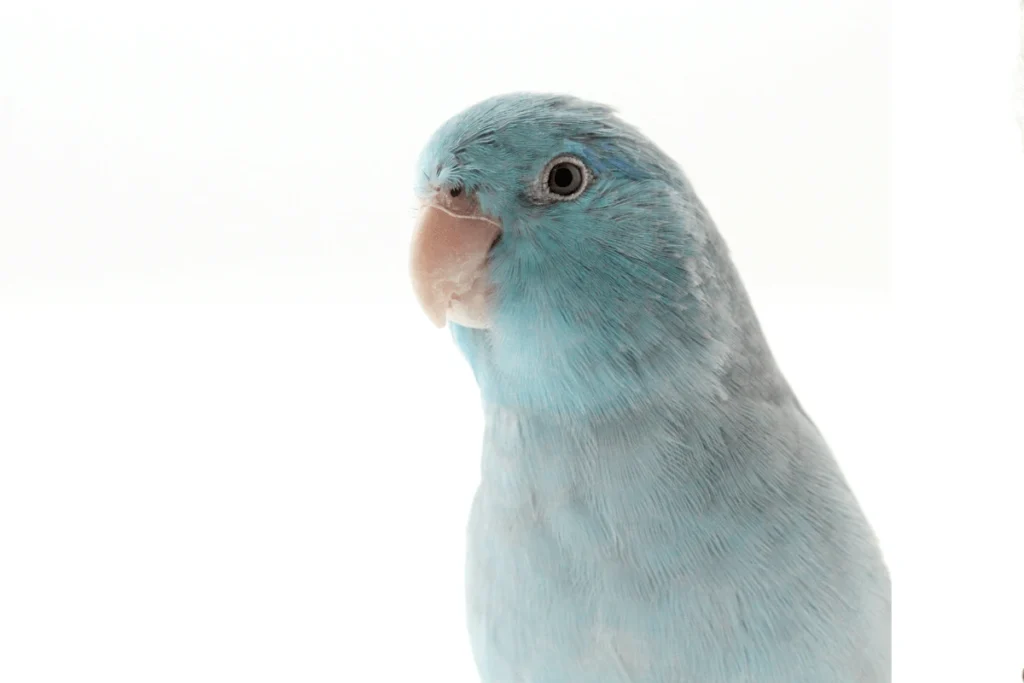
Health and Grooming Tips for a Happy Parrotlet
Turquoise Parrotlet Health Tips
Keeping a Turquoise Parrotlet healthy requires regular monitoring, a proper diet, and preventive care. Since parrotlets are small and energetic, any signs of illness can quickly become serious if not addressed. A healthy parrotlet should have bright, alert eyes, smooth feathers, an active personality, and a good appetite.
One of the most common health concerns in parrotlets is obesity, often caused by a diet too high in seeds and not enough exercise. Encourage activity by providing ample space for flying and a variety of bird toys and enrichment to keep them physically engaged. Vitamin deficiencies can also occur if their diet lacks fresh vegetables and high-quality pellets, leading to issues like feather plucking or weak bones.
Respiratory infections are another risk, often caused by exposure to drafts, smoke, or strong household chemicals like air fresheners and non-stick cookware fumes. If your parrotlet starts sneezing frequently, wheezing, or has nasal discharge, seek veterinary care immediately. Regular check-ups with an avian veterinarian help catch potential problems early and ensure your bird stays in peak health.
Behavioral changes, such as lethargy, fluffed-up feathers, or decreased appetite, are often early warning signs of illness. Always observe your bird’s normal activity levels and eating habits—any sudden changes could indicate a health issue that needs attention.
Turquoise Parrotlet Grooming
Proper grooming keeps your Turquoise Parrotlet looking and feeling its best. These birds are naturally good at preening themselves, but they still require some assistance with grooming.
Bathing is essential for maintaining healthy feathers and skin. Most parrotlets enjoy splashing in shallow water or misting with a spray bottle. Offer a small dish of lukewarm water a few times a week, especially in dry climates, to prevent flaky skin and encourage natural preening behaviors.
Nail trimming should be done as needed, usually every few months. Overgrown nails can make perching difficult and may cause injuries. If your parrotlet’s nails become too sharp or long, use a small bird-safe nail clipper or have a veterinarian or bird groomer handle the trimming.
Beak overgrowth is uncommon in healthy parrotlets but can occur due to poor diet or lack of chewable toys. Providing wooden perches, cuttlebones, and mineral blocks helps naturally wear down their beak and prevents abnormalities.
Regularly check your bird’s feathers for signs of stress-related plucking or molting issues. If you notice bald spots or excessive feather loss, consult an avian vet to rule out medical conditions or stress-related behaviors.
Wing Clipping (Optional)
Wing clipping is a personal and sometimes controversial choice among bird owners. Some prefer to clip their Turquoise Parrotlet’s wings to prevent accidents, while others believe in allowing full flight for exercise and mental stimulation.
If you choose to clip, it should always be done by an experienced professional or avian veterinarian to ensure the bird’s safety. A proper clip removes a few primary flight feathers while still allowing controlled gliding instead of complete loss of flight. Incorrect clipping can lead to injuries, loss of balance, and emotional stress.
For those who prefer to keep their parrotlet fully flighted, ensuring a bird-safe environment is essential. Close windows and doors, cover mirrors, and eliminate hazards like ceiling fans or toxic household fumes to prevent accidents. Some owners opt for recall training, teaching their birds to fly to them on command for added control and safety.
Regardless of the decision to clip or not, providing ample playtime, mental stimulation, and safe out-of-cage experiences ensures a happy and well-adjusted parrotlet.
Conclusion
Caring for a Turquoise Parrotlet is a rewarding experience, but it requires commitment, patience, and proper knowledge to ensure their well-being. These tiny parrots may be small in size, but their bold personalities, intelligence, and playful nature make them a joy to own. Providing the right parrotlet cage setup, a nutritious Turquoise Parrotlet diet, and plenty of bird toys and enrichment helps keep them happy, healthy, and mentally stimulated.
Building a strong bond with a Turquoise Parrotlet starts with hand-taming techniques, positive reinforcement, and daily socialization. These birds thrive on interaction and enjoy being part of their owner’s daily routine. Training them with consistency and patience not only prevents unwanted behaviors but also strengthens trust, making them affectionate and well-mannered companions.
Maintaining good Turquoise Parrotlet health involves a balanced diet, regular vet check-ups, and a bird-safe environment free from toxins and hazards. Proper parrotlet grooming, including nail trims, bathing, and beak maintenance, contributes to their overall well-being. Owners must also decide whether wing clipping is the right choice for their bird’s safety and lifestyle.
Owning a Turquoise Parrotlet is a long-term commitment, as these birds can live up to 20 years. Their care goes beyond food and shelter—it involves creating a loving and enriching environment where they can thrive. With proper attention, training, and affection, a Turquoise Parrotlet becomes more than just a pet; they become a cherished and lively companion that brightens every day.
Read About The Adorable Riparian Parrotlet in this Article.
Read About Other Pets and breeds From HERE!
Find Out the Best stuff for your Pet On Pet MD Official.
